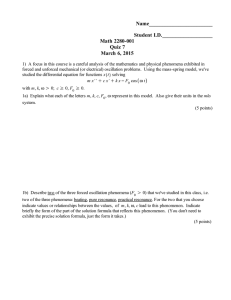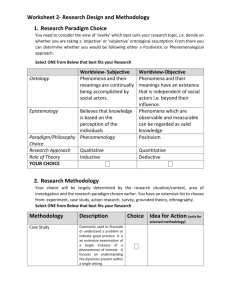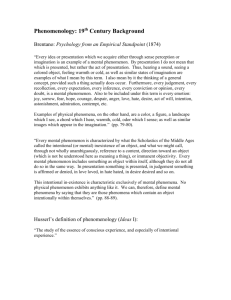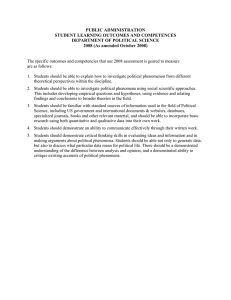ZEN. . . AND THE ART OF DEBUNKERY and: page:
advertisement
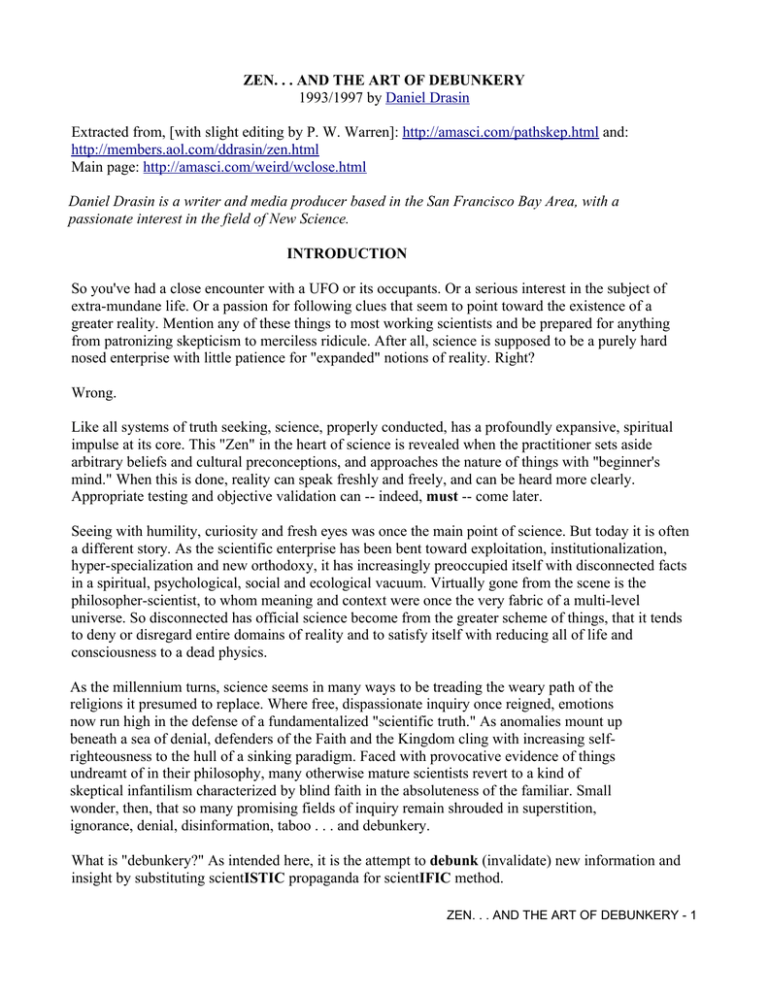
ZEN. . . AND THE ART OF DEBUNKERY 1993/1997 by Daniel Drasin Extracted from, [with slight editing by P. W. Warren]: http://amasci.com/pathskep.html and: http://members.aol.com/ddrasin/zen.html Main page: http://amasci.com/weird/wclose.html Daniel Drasin is a writer and media producer based in the San Francisco Bay Area, with a passionate interest in the field of New Science. INTRODUCTION So you've had a close encounter with a UFO or its occupants. Or a serious interest in the subject of extra-mundane life. Or a passion for following clues that seem to point toward the existence of a greater reality. Mention any of these things to most working scientists and be prepared for anything from patronizing skepticism to merciless ridicule. After all, science is supposed to be a purely hard nosed enterprise with little patience for "expanded" notions of reality. Right? Wrong. Like all systems of truth seeking, science, properly conducted, has a profoundly expansive, spiritual impulse at its core. This "Zen" in the heart of science is revealed when the practitioner sets aside arbitrary beliefs and cultural preconceptions, and approaches the nature of things with "beginner's mind." When this is done, reality can speak freshly and freely, and can be heard more clearly. Appropriate testing and objective validation can -- indeed, must -- come later. Seeing with humility, curiosity and fresh eyes was once the main point of science. But today it is often a different story. As the scientific enterprise has been bent toward exploitation, institutionalization, hyper-specialization and new orthodoxy, it has increasingly preoccupied itself with disconnected facts in a spiritual, psychological, social and ecological vacuum. Virtually gone from the scene is the philosopher-scientist, to whom meaning and context were once the very fabric of a multi-level universe. So disconnected has official science become from the greater scheme of things, that it tends to deny or disregard entire domains of reality and to satisfy itself with reducing all of life and consciousness to a dead physics. As the millennium turns, science seems in many ways to be treading the weary path of the religions it presumed to replace. Where free, dispassionate inquiry once reigned, emotions now run high in the defense of a fundamentalized "scientific truth." As anomalies mount up beneath a sea of denial, defenders of the Faith and the Kingdom cling with increasing selfrighteousness to the hull of a sinking paradigm. Faced with provocative evidence of things undreamt of in their philosophy, many otherwise mature scientists revert to a kind of skeptical infantilism characterized by blind faith in the absoluteness of the familiar. Small wonder, then, that so many promising fields of inquiry remain shrouded in superstition, ignorance, denial, disinformation, taboo . . . and debunkery. What is "debunkery?" As intended here, it is the attempt to debunk (invalidate) new information and insight by substituting scientISTIC propaganda for scientIFIC method. ZEN. . . AND THE ART OF DEBUNKERY - 1 To throw this kind of pseudo scientific behavior into bold -- if somewhat comic -- relief, I have assembled below a useful "how-to" guide for aspiring debunkers, with a special section devoted to debunking extraterrestrial intelligence -- perhaps the most aggressively debunked subject in the whole of modern history. As will be obvious to the reader, I have carried a few of these debunking strategies over the threshold of absurdity for the sake of making a point. As for the rest, their inherently fallacious reasoning, twisted logic and sheer goofiness will sound frustratingly familiar to those who have dared explore beneath the ocean of denial and attempted in good faith to report back about what they found there. So without further ado . . . == HOW TO DEBUNK JUST ABOUT ANYTHING == PART 1: GENERAL DEBUNKERY 1.Before commencing to debunk, prepare your equipment. Equipment needed: one armchair. 2. Put on the right face. Cultivate a condescending air that suggests that your personal opinions are backed by the full faith and credit of God. Employ vague, subjective, dismissive terms such as "ridiculous" or "trivial" in a manner that suggests they have the full force of scientific authority. 3. Portray science not as an open-ended process of discovery but as a holy war against unruly hordes of quackery-worshiping infidels. Since in war the ends justify the means, you may fudge, stretch or violate scientific method, or even omit it entirely, in the name of defending scientific method. 4. Keep your arguments as abstract and theoretical as possible. This will "send the message" that accepted theory overrides any actual evidence that might challenge it -- and that therefore no such evidence is worth examining. 5. Reinforce the popular misconception that certain subjects are inherently unscientific. In other words, deliberately confuse the process of science with the content of science. (Someone may, of course, object that science must be neutral to subject matter and that only the investigative process can be scientifically responsible or irresponsible. If that happens, dismiss such objections using a method employed successfully by generations of politicians: simply reassure everyone that "there is no contradiction here.") 6. Arrange to have your message echoed by persons of authority. The degree to which you can stretch the truth is directly proportional to the prestige of your mouthpiece. 7. Always refer to unorthodox statements as "claims," which are "touted," and to your own assertions as "facts," which are "stated." 8. Avoid examining the actual evidence. This allows you to say with impunity, "I have seen absolutely no evidence to support such ridiculous claims!" (Note that this technique has withstood the test of time, and dates back at least to the age of Galileo. By simply refusing to look through his telescope, the ecclesiastical authorities bought the Church over three centuries' worth of denial free and clear!) ZEN. . . AND THE ART OF DEBUNKERY - 2 9. If examining the evidence becomes unavoidable, report back that "there is nothing new here!" If confronted by a watertight body of evidence that has survived the most rigorous tests, simply dismiss it as being "too pat." 10. Equate the necessary skeptical component of science with all of science. Emphasize the narrow, stringent, rigorous and critical elements of science to the exclusion of intuition, inspiration, exploration and integration. If anyone objects, accuse them of viewing science in exclusively fuzzy, subjective or metaphysical terms. 11. Insist that the progress of science depends on explaining the unknown in terms of the known. In other words, science equals reductionism. You can apply the reductionist approach in any situation by discarding more and more and more evidence until what little is left can finally be explained entirely in terms of established knowledge. 12. Downplay the fact that free inquiry, legitimate disagreement and respectful debate are a normal part of science. 13. Make yourself available to media producers who seek "balanced reporting" of unorthodox views. However, agree to participate in only those presentations whose time constraints and a-priori bias preclude such luxuries as discussion, debate and crossexamination. 14. At every opportunity reinforce the notion that what is familiar is necessarily rational. The unfamiliar is therefore irrational, and consequently inadmissible as evidence. 15. State categorically that the unconventional arises exclusively from the "will to believe" and may be dismissed as, at best, an honest misinterpretation of the conventional. 16. Characterize your opponents as "uncritical believers." Summarily dismiss the notion that debunkery itself betrays uncritical belief, albeit in the status quo. 17. Maintain that in investigations of unconventional phenomena, a single flaw invalidates the whole. In conventional contexts, however, you may sagely remind the world that, "after all, situations are complex and human beings are imperfect." 18. "Occam's Razor," or the "principle of parsimony," says the correct explanation of a mystery will usually involve the simplest fundamental principles. Insist, therefore, that the most familiar explanation is by definition the simplest! Imply strongly that Occam's Razor is not merely a philosophical rule of thumb but an immutable law. 19. Discourage any study of history that may reveal today's dogma as yesterday's heresy. Likewise, avoid discussing the many historical, philosophical and spiritual parallels between science and democracy. 20. Since the public tends to be unclear about the distinction between evidence and proof, do your best to help maintain this murkiness. If absolute proof is lacking, state categorically that there is no ZEN. . . AND THE ART OF DEBUNKERY - 3 evidence. 21. If sufficient evidence has been presented to warrant further investigation of an unusual phenomenon, argue that "evidence alone proves nothing!" Ignore the fact that preliminary evidence is not supposed to prove anything. 22. In any case, imply that proof precedes evidence. This will eliminate the possibility of initiating any meaningful process of investigation -- particularly if no criteria of proof have yet been established for the phenomenon in question. 23. Insist that criteria of proof cannot possibly be established for phenomena that do not exist! 24. Although science is not supposed to tolerate vague or double standards, always insist that unconventional phenomena must be judged by a separate, yet ill-defined, set of scientific rules. Do this by declaring that "extraordinary claims demand extraordinary evidence" -- but take care never to define where the "ordinary" ends and the "extraordinary" begins. This will allow you to manufacture an infinitely receding evidential horizon, i.e., to define "extraordinary" evidence as that which lies just out of reach at any point in time. 25. In the same manner, insist on classes of evidence that are impossible to obtain. For example, declare that unidentified aerial phenomena may be considered real only if we can bring them into laboratories to strike them with hammers and analyze their physical properties. Disregard the accomplishments of the inferential sciences--astronomy, for example, which gets on just fine without bringing actual planets, stars, galaxies and black holes into its labs and striking them with hammers. 26. Practice debunkery-by-association. Lump together all phenomena popularly deemed paranormal and suggest that their proponents and researchers speak with a single voice. In this way you can indiscriminately drag material across disciplinary lines or from one case to another to support your views as needed. For example, if a claim having some superficial similarity to the one at hand has been (or is popularly assumed to have been) exposed as fraudulent, cite it as if it were an appropriate example. Then put on a gloating smile, lean back in your armchair and just say "I rest my case." 27. Use the word "imagination" as an epithet that applies only to seeing what's not there, and not to denying what is there. 28. If a significant number of people agree that they have observed something that violates the consensus reality, simply ascribe it to "mass hallucination." Avoid addressing the possibility that the consensus reality, which is routinely observed by millions, might itself constitute a mass hallucination. 29. Ridicule, ridicule, ridicule. It is far and away the single most chillingly effective weapon in the war against discovery and innovation. Ridicule has the unique power to make people of virtually any persuasion go completely unconscious in a twinkling. It fails to sway only those few who are of sufficiently independent mind not to buy into the kind of emotional consensus that ridicule provides. 30. By appropriate innuendo and example, imply that ridicule constitutes an essential feature of scientific method that can raise the level of objectivity, integrity and dispassionateness with which any ZEN. . . AND THE ART OF DEBUNKERY - 4 investigation is conducted. 31. If pressed about your novel interpretations of the scientific method, declare that "intellectual integrity is a subtle issue." 32. Imply that investigators of the unorthodox are zealots. Suggest that in order to investigate the existence of something one must first believe in it absolutely. Then demand that all such "true believers" know all the answers to their most puzzling questions in complete detail ahead of time. Convince people of your own sincerity by reassuring them that you yourself would "love to believe in these fantastic phenomena." Carefully sidestep the fact that science is not about believing or disbelieving, but about finding out. 33. Use "smoke and mirrors," i.e., obfuscation and illusion. Never forget that a slippery mixture of fact, opinion, innuendo, out-of-context information and outright lies will fool most of the people most of the time. As little as one part fact to ten parts B.S. will usually do the trick. (Some veteran debunkers use homeopathic dilutions of fact with remarkable success!) Cultivate the art of slipping back and forth between fact and fiction so undetectably that the flimsiest foundation of truth will always appear to firmly support your entire edifice of opinion. 34. Employ "TCP": Technically Correct Pseudo-refutation. Example: if someone remarks that all great truths began as blasphemies, respond immediately that not all blasphemies have become great truths. Because your response was technically correct, no one will notice that it did not really refute the original remark. 35. Trivialize the case by trivializing the entire field in question. Characterize the study of orthodox phenomena as deep and time consuming, while deeming that of unorthodox phenomena so insubstantial as to demand nothing more than a scan of the tabloids. If pressed on this, simply say "but there's nothing there to study!" Characterize any serious investigator of the unorthodox as a "buff" or "freak," or as "self-styled" -- the media's favorite code-word for "bogus." 36. Remember that most people do not have sufficient time or expertise for careful discrimination, and tend to accept or reject the whole of an unfamiliar situation. So discredit the whole story by attempting to discredit part of the story. Here's how: a) take one element of a case completely out of context; b) find something prosaic that hypothetically could explain it; c) declare that therefore that one element has been explained; d) call a press conference and announce to the world that the entire case has been explained! 37. Engage the services of a professional stage magician who can mimic the phenomenon in question; for example, ESP, psychokinesis or levitation. This will convince the public that the original claimants or witnesses to such phenomena must themselves have been (or been fooled by) talented stage magicians who hoaxed the original phenomenon in precisely the same way. 38. Find a prosaic phenomenon that resembles, no matter how superficially, the claimed phenomenon. Then suggest that the existence of the commonplace look-alike somehow forbids the existence of the genuine article. For example, imply that since people often see "faces" in rocks and clouds, the enigmatic Face on Mars must be a similar illusion and therefore cannot possibly be artificial. ZEN. . . AND THE ART OF DEBUNKERY - 5 39. When an unexplained phenomenon demonstrates evidence of intelligence (as in the case of the mysterious crop circles) focus exclusively on the mechanism that might have been wielded by the intelligence rather than the intelligence that might have wielded the mechanism. The more attention you devote to the mechanism, the more easily you can distract people from considering the possibility of non-ordinary intelligence. 40. Accuse investigators of unusual phenomena of believing in "invisible forces and extrasensory realities." If they should point out that the physical sciences have always dealt with invisible forces and extrasensory realities (gravity? electromagnetism? . . . ) respond with a condescending chuckle that this is "a naive interpretation of the facts." 41. Insist that western science is completely objective, and is based on no untestable assumptions, covert beliefs or ideological interests. If an unfamiliar or inexplicable phenomenon happens to be considered true and/or useful by a non-western or other traditional society, you may therefore dismiss it out of hand as "ignorant misconception," "medieval superstition" or "fairy lore." 42. Label any poorly understood phenomenon "occult," "paranormal," "metaphysical," "mystical" or "supernatural." This will get most mainstream scientists off the case immediately on purely emotional grounds. If you're lucky, this may delay any responsible investigation of such phenomena by decades or even centuries! 43. Ask questions that appear to contain generally-assumed knowledge that supports your views; for example, "why do no police officers, military pilots, air traffic controllers or psychiatrists report UFOs?" (If someone points out that they do, insist that those who do must be mentally unstable.) 44. Ask unanswerable questions based on arbitrary criteria of proof. For example, "if this claim were true, why haven't we seen it on TV?" or "in this or that scientific journal?" Never forget the mother of all such questions: "If UFOs are extraterrestrial, why haven't they landed on the White House lawn?" 45. Similarly, reinforce the popular fiction that our scientific knowledge is complete and finished. Do this by asserting that "if such-and-such were true, we would would already know about it!" 46. Remember that you can easily appear to refute anyone's claims by building "straw men" to demolish. One way to do this is to misquote them while preserving that convincing grain of truth; for example, by acting as if they have intended the extreme of any position they've taken. Another effective strategy with a long history of success is simply to mis-replicate their experiments -- or to avoid replicating them at all on grounds that to do so would be ridiculous or fruitless. To make the whole process even easier, respond not to their actual claims but to their claims as reported by the media, or as propagated in popular myth. 47. Insist that such-and-such unorthodox claim is not scientifically testable because no self-respecting grant making organization would fund such ridiculous tests. 48. Be selective. For example, if an unorthodox healing method has failed to reverse a case of terminal illness you may deem it worthless while taking care to avoid mentioning any of the shortcomings of conventional medicine. ZEN. . . AND THE ART OF DEBUNKERY - 6 49. Hold claimants responsible for the production values and editorial policies of any media or press that reports their claim. If an unusual or inexplicable event is reported in a sensationalized manner, hold this as proof that the event itself must have been without substance or worth. 50. When a witness or claimant states something in a manner that is scientifically imperfect, treat this as if it were not scientific at all. If the claimant is not a credentialed scientist, argue that his or her perceptions cannot possibly be objective. 51. If you're unable to attack the facts of the case, attack the participants -- or the journalists who reported the case. Ad-hominem arguments, or personality attacks, are among the most powerful ways of swaying the public and avoiding the issue. For example, if investigators of the unorthodox have profited financially from activities connected with their research, accuse them of "profiting financially from activities connected with their research!" If their research, publishing, speaking tours and so forth, constitute their normal line of work or sole means of support, hold that fact as "conclusive proof that income is being realized from such activities!" If they have labored to achieve public recognition for their work, you may safely characterize them as "publicity seekers." 53. Fabricate supportive expertise as needed by quoting the opinions of those in fields popularly assumed to include the necessary knowledge. Astronomers, for example, may be trotted out as experts on the UFO question, although course credits in ufology have never been a prerequisite for a degree in astronomy. 54. Fabricate confessions. If a phenomenon stubbornly refuses to go away, set up a couple of colorful old geezers to claim they hoaxed it. The press and the public will always tend to view confessions as sincerely motivated, and will promptly abandon their critical faculties. After all, nobody wants to appear to lack compassion for self-confessed sinners. 55. Fabricate sources of disinformation. Claim that you've "found the person who started the rumor that such a phenomenon exists!" 56. Fabricate entire research projects. Declare that "these claims have been thoroughly discredited by the top experts in the field!" Do this whether or not such experts have ever actually studied the claims, or, for that matter, even exist. PART 2: DEBUNKING EXTRATERRESTRIAL INTELLIGENCE 1. Point out that an "unidentified" flying object is just that, and cannot be automatically assumed to be extraterrestrial. Do this whether or not anyone involved has assumed it to be extraterrestrial. 2. Equate nature's laws with our current understanding of nature's laws. Then label all concepts such as anti-gravity or inter-dimensional mobility as mere flights of fancy "because obviously they would violate nature's laws." Then if a UFO is reported to have hovered silently, made right-angle turns at supersonic speeds or appeared and disappeared instantly, you may summarily dismiss the report. 3. Declare that there is no proof that life can exist in outer space. Since most people still behave as if the Earth were the center of the universe, you may safely ignore the fact that Earth, which is already in ZEN. . . AND THE ART OF DEBUNKERY - 7 outer space, has abundant life. 4. Point out that the government-sponsored SETI program assumes in advance that extraterrestrial intelligence can only exist light-years away from Earth. Equate this a-priori assumption with conclusive proof; then insist that this invalidates all terrestrial reports of ET contact. 5. If compelling evidence is presented for a UFO crash or some similar event, provide thousands of pages of detailed information about a formerly secret military project that might conceivably account for it. The more voluminous the information, the less the need to demonstrate any actual connection between the reported event and the military project. 6. When someone produces purported physical evidence of alien technology, point out that no analysis can prove that its origin was extraterrestrial; after all, it might be the product of some perfectly ordinary, ultra-secret underground government lab. The only exception would be evidence obtained from a landing on the White House lawn -- the sole circumstance universally agreed upon by generations of skeptics as conclusively certifying extraterrestrial origin! 7. If photographs or other visual media depicting anomalous aerial phenomena have been presented, argue that since images can now be digitally manipulated they prove nothing. Assert this regardless of the vintage of the material or the circumstances of its acquisition. Insist that the better the quality of a UFO photo, the greater the likelihood of fraud. Photos that have passed every known test may therefore be held to be the most perfectly fraudulent of all! 8. If you can't otherwise destroy the credibility of a UFO photo, plant a small model of the alleged craft near the photographer's home where it can be conveniently discovered and whisked off to the local media. The model need not resemble the original too closely; as long as the press says it's a dead ringer nobody will question the implication of fraud. 9. Argue that all reports of humanoid extraterrestrials must be bogus because the evolution of the humanoid form on Earth is the result of an infinite number of accidents in a genetically isolated environment. Avoid addressing the logical proposition that if interstellar visitations have occurred, Earth cannot be considered genetically isolated in the first place. 10. Argue that extraterrestrials would or wouldn't, should or shouldn't, can or can't behave in certain ways because such behavior would or wouldn't be logical. Base your notions of logic on how terrestrials would or wouldn't behave. Since terrestrials behave in all kinds of ways you can theorize whatever kind of behavior suits your arguments. 11. Stereotype contact claims according to simplistic scenarios already well established in the collective imagination. If a reported ET contact appears to have had no negative consequences, sarcastically accuse the claimant of believing devoutly that "benevolent ETs have come to magically save us from destroying ourselves!" If someone claims to have been traumatized by an alien contact, brush it aside as "a classic case of hysteria." If contactees stress the essential humanness and limitations of certain ETs they claim to have met, ask "why haven't these omnipotent beings offered to solve all our problems for us?" 12. When reluctant encounter witnesses step forward, accuse them indiscriminately of "seeking the ZEN. . . AND THE ART OF DEBUNKERY - 8 limelight" with their outlandish stories 13. Ask why alleged contactees and abductees haven't received alien infections. Reject as "preposterous" all medical evidence suggesting that such may in fact have occurred. Categorize as "pure science-fiction" the notion that alien understandings of immunology might be in advance of our own, or that sufficiently alien microorganisms might be limited in their ability to interact with our biological systems. Above all, dismiss anything that might result in an actual investigation of the matter. 14. Travel to China. Upon your return, report that "nobody there told me they had seen any UFOs." Insist that this proves that no UFOs are reported outside countries whose populations are overexposed to science fiction. 15. Where hypnotic regression has yielded consistent contactee testimony in widespread and completely independent cases, argue that hypnosis is probably unreliable, and is always worthless in the hands of non-credentialed practitioners. Be sure to add that the subjects must have been steeped in the UFO literature, and that, whatever their credentials, the hypnotists involved must have been asking leading questions. 16. If someone claims to have been emotionally impacted by a contact experience, point out that strong emotions can alter perceptions. Therefore, the claimant's recollections must be entirely untrustworthy. 17. Maintain that there cannot possibly be a government UFO cover up but that it exists for legitimate reasons of national security! 18. Accuse conspiracy theorists of being conspiracy theorists and of believing in conspiracies! Insist that only accidentalist theories can possibly account for repeated, organized patterns of suppression, denial and disinformational activity. 19. Argue that since theoretically there can be no press censorship in the United States, there is no press censorship in the United States. 20. In the event of a worst-case scenario -- for example, one in which the UFO is suddenly acknowledged as a global mystery of millennial proportions -- just remember that the public has a short memory. Simply say dismissively, "Well, everyone knows this is a monumentally significant issue. As a matter of fact, my colleagues and I have been remarking on it for years!" ***************** This article may be posted electronically provided that it is transmitted unaltered, in its entirety, and without charge. ZEN. . . AND THE ART OF DEBUNKERY - 9
